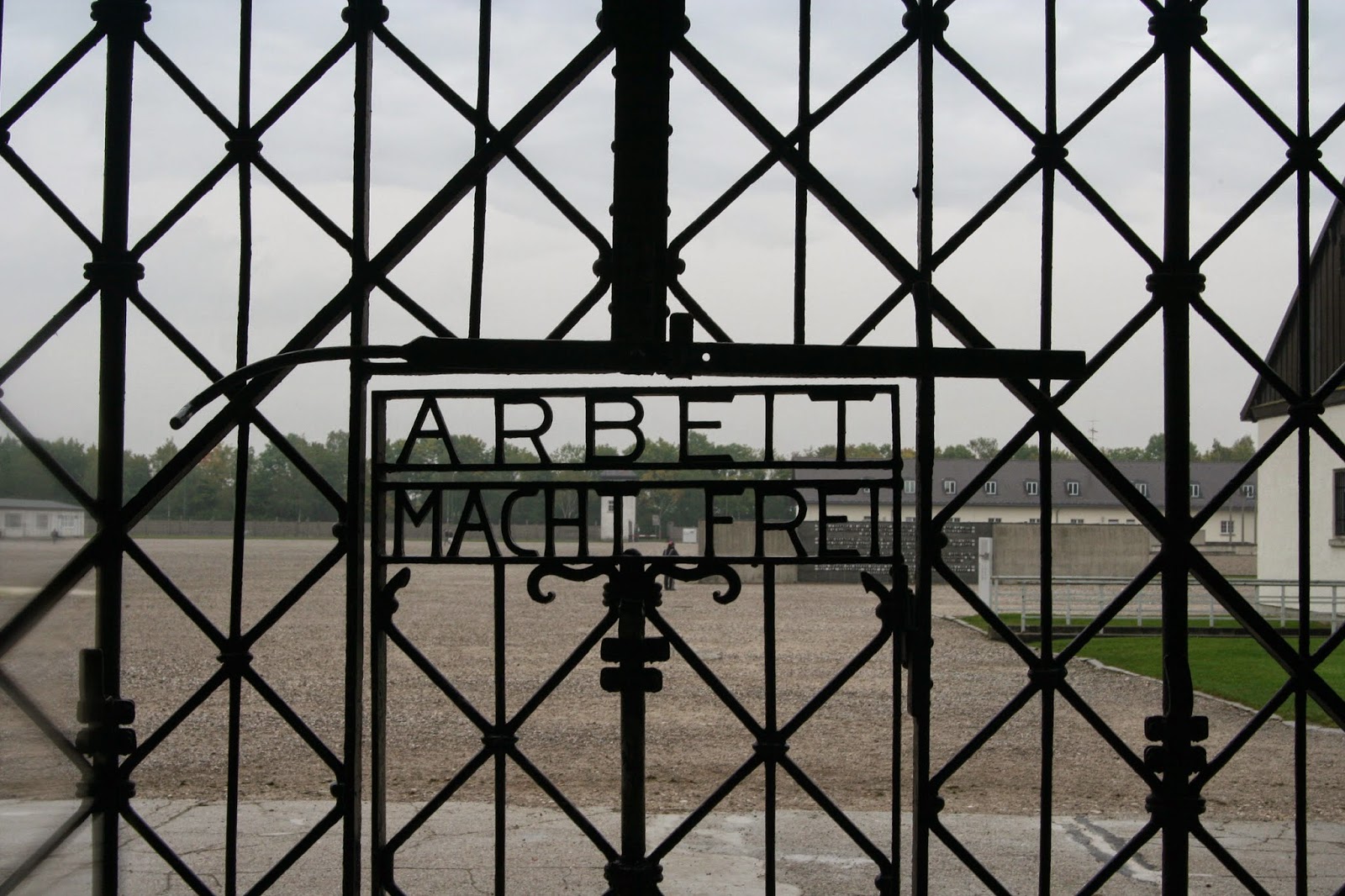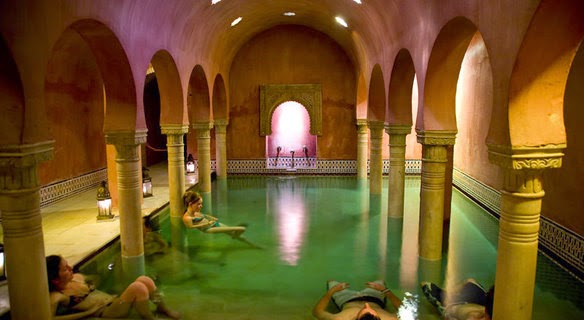Dachau Concentration Camp: Arbeit Macht Frei (Munich, Germany)
I was originally going to wait to post absolutely anything until the end of our Semana Santa trip when I was back in Spain, but after the emotional and psychologically exhausting experience I had today I was unable to wait. I don't have photos to match up with everything I have written about because at the time of the tour it felt incredibly wrong to be continually taking photos. During the tour I was working hard to respect and remember the lives and losses that the victims experienced. Not capturing their final moments through a lens.
-----------
-----------
Today we experienced Dachau Concentration camp and it was as
absolutely as emotionally draining as you can imagine. Actually, our tour guide
pointed out to us that during her training they said to avoid the word
“imagine” during any description, because there is no possible way that someone
could fully understand the absolute horror of the concentration camps. Today was our warmest so far in Germany, but the chills were continuous as we read,
heard, and saw the deeper workings of the concentration camp.
Entering Dachau there is a gate that reads “Arbeit macht
frei” translating to work will make you free.
The meaning of this is great and varying depending on the background of
the reader. The people of the town, when touring the concentration camp during
the war, saw this as a positive and constructive statement...that if the
members of the camp worked hard enough they would be rehabilitated back into
society for their wrongs they committed. For the prisoners of the camp, who did
no wrong, it meant working themselves to death so their soul had a possibility of
escaping the camp. The morbid and disturbing irony is not lost on present day
visitors to the memorial.
The energy the camp emanates is impossible to put into words.
The energy the camp emanates is impossible to put into words.
After walking through the main gates my eyes scanned the
barren and desolate gravel square where roll call was taken day and night. It
was haunting and eerie, but I’m sure all of the spirits of the victims have
long since moved onwards as they acquired the freedom they rightfully deserved.
The goal of the camps was to dehumanize and break the spirit
of any person who entered the gates. The victims were referred to by a number
and the psychological torture they endured was endless. Their heads were
shaved, their possessions taken, and any comforts humans experienced were
removed. In the Nazis book they were below animals, and honestly, more
worthless than the ground those animals walked on. The prisoners were given
identical uniforms; the pants had pockets that were unable to be used. If a
prisoner was caught with their hands in their pockets they were subject to
extreme punishment that had the possibility of resulting in death. The first
set of barracks had shelves above the beds to remind the incoming that they
were possession less and unworthy. The mind games, cruelty, and inhumanity of
the Nazis is indescribable.
The entire time I was walking through the camp I felt ill,
the Nazis were humans and the victims were humans. How can this kind of
inhumanity exist in such a recent past? The ranking of humans based on
political affiliation, skin color, religion, and nationality being used as a
base for worthiness of life is once again inconceivable. But as Miep Gies (one of the individuals who
hid Anne Frank's family) said “I certainly think that another Holocaust can
happen again. It did already occur; think of Cambodia, Rwanda, and Bosnia”. It
is not so much the recent past, but the living present.
I found myself again, near tears as we walked through the
crematorium and gas chambers. The door was labeled “showers” so that the guards
would not be met with resistance as they filed the unclothed masses into the
chamber. One “shower head” remains in the gas chamber of Dachau, and seeing it
and trying to understand the deception that was experienced before someone took
their last breaths was unbearable. The following room was the crematory where 3
bodies would be put into the oven at a time. Towards the end of the war the
supply of coal was cut off and the ground was too cold to dig holes so the
piles of skeleton-like bodies began to stack up higher and higher around the
camp. These are the photos that are often seen when you look up information
about how the camps were found at the time of liberation.
During the time in the camp I found myself upset that there
wasn’t an age minimum for entrance, seeing children the age of 5 running around
laughing and enjoying the sun is one of the most ironically disgusting things
I’ve ever experienced. I saw the kids dragging each other across the grass, and
playing as children play. The same grass that a prisoner of the camp, needed to
only set one toe on in order to be shot multiple times with a machine gun that
was aimed to kill. Stepping on the grass was suicidal for the victims of
Dachau, and I don’t think it was right that it was trampled by wide eyed and
naive children who don’t understand the value of treading on that area of land
and being able to live to see another day.
I want so terribly to
be able to fluently write and be able to portray what I experienced today by
walking through the same doors and hallways as the victims of Dachau, but I
find myself at a loss of words as my stomach turns and my head begins to spin
just as it did as I stood in the camp. I can’t organize my thoughts, and I
surely can’t organize this post. All of the history books and movies in the
world could not suffice for walking on the ground of the unlucky people who
were forced into this fight for survival.
I want to move on to the memorials that are now present
within the camp. There are buildings dedicated to Catholics, Protestants,
Russian-orthodox, and Jews. I’m going to describe the two that resonated with me
the most:
The Jewish
memorial was a set of stairs leading down to a prayer alter roughly six feet
below the ground resulting in pitch darkness. Above the prayer table there is
an opening in the ceiling that allows the light of day into the room
symbolizing that even in the darkest of times, hope is present.
The
Protestant Church of Reconciliation. This building is broken and irregular and
void of any sort of right angle or sense of order. This is to counteract the
lifestyle the Nazis inflicted on the victims of both the tight and precise
right corners of the swastika as well as the right-angled barracks and straight
lines that needed to be present in order to escape punishment.
And finally, the most striking memorial, in my opinion, was
outside of the crematorium and gas chamber their stands a statue that at first
glance looks like a prisoner, but upon further inspection is a free man. The
tell tale signs of a prisoner are a straight backed stance, hands out of
pockets, eyes facing down, and face in line with the rest of their body. This
man had a causal stance with his hands in his pockets as his eyes looked off to
the left into the distance. Below the statue there was a message that
translates “To honor the dead and to warn the living”.
This memorial will forever instill in me the horror that
humanity is capable of. It is also important to remember that in these times of
darkness the victims of the camp managed to shine a light on each other, by
giving a hand to their fellow prisoners, by showing the incoming people the ways
of the camp, or by carrying their fellow man to roll call so they wouldn’t
suffer the consequences of being counted missing.
 |
| This memorial shows that even though the bodies are skeletal they are still banding together. |
Humanity is never completely lost.






I'm very well-read when it comes to historical references and personal victim accounts of the Holocaust, ghettos, and concentration/extermination camps. However, hearing your experience as a friend gave me chills, and I hope one day I will have the same draining but impactful experience.
ReplyDeleteEmily, this blog post was very moving. Thank you for sharing your very raw experience with us readers. Like you said, I'm sure that much of what was felt cannot be put into words. Even still, this was very insightful and haunting for me. I appreciate it!
ReplyDelete